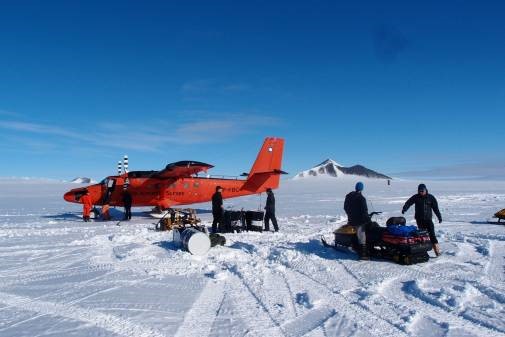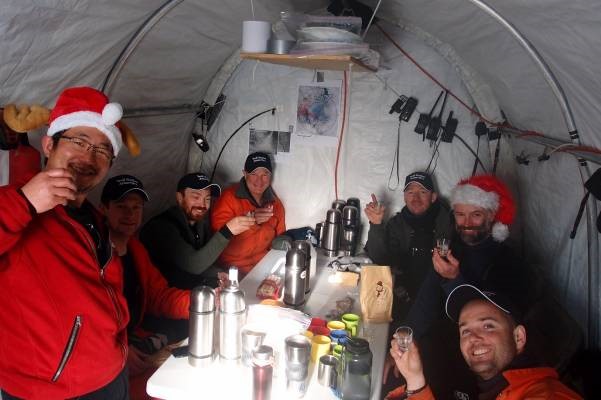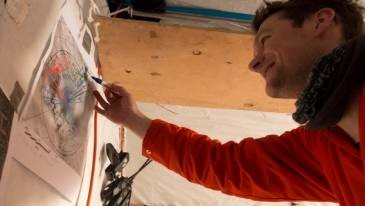One week on from departing Rothera into the field and the first leg of the PolarGAP survey at FD83 is almost over, I get to sit back, relax a bit and write this blog. The transit from Rothera to the remote FD83 field camp went remarkably smoothly.

Refuelling at Sky Blu (Arne Olesen)
My first night in the field was spent at a place called Sky Blu. This is one of BAS’s main field fuel depots, which is manned all summer long providing a refuelling point, tea stop and occasional overnight accommodation for scientists travelling further south from Rothera. The survey aircraft, and accompanying utility aircraft, arrived in bright blue sky and sunshine, but by the next morning low cloud covered the entire camp with the Twin Otters barely visible just 500m away. Over the next three hours of anxious waiting glimpses of the mountains around the camp began to appear, until finally visibility was good enough and we could depart.

BAS Twin Otter fleet all on the ground at the Tango drilling camp
From Sky Blu it was a four hour flight eastward across the Ronnie/Filchner Ice Shelf to a remote hot water drilling camp called Tango. Here scientists are using hot water to bore through the floating ice shelf to investigate the normally inaccessible ocean below, and the sediments beneath. The measurements they are making will help predict if and how warm ocean water could move beneath the ice shelf. The mobile drilling camp also provided the ideal place to refuel before the final leg into FD83. In fact, it provided such an ideal place to refuel that all four BAS Twin Otters were on the ground away from Rothera at the same time, an extremely rare occurrence.

Field camp at FD83 (Arne Olesen)
From Tango we took off for the final leg of the journey up to FD83. Another four hour flight up to the place I have been calling home for the last week. On arrival looking out of the Twin Otter there was blue sky and sunshine. However, as I stepped out onto the snow I was instantly hit by the cold, –30°C by the aircraft temperature gauge. A light breeze was blowing and all the clothes I had put on at Rothera seemed completely inadequate. My sunglasses instantly steamed up, which together with the shock of the cold, and the breathlessness of sudden arrival at an altitude of 2600 m made me feel physically sick. Slowly as the aircraft were re-fuelled and unloaded, and we stepped into the heated kitchen tent normality began to return. After the initial shock of the cold on arrival camp life has settled into a comfortable routine, and with some extra layers the temperatures are ok, though even a light breeze can make it uncomfortable to be outside for too long.

Celebrating the progress of the survey so far (Arne Olesen)
The camp at FD83 is provided by the Norwegian Polar Institute (NPI), and is manned by two staff. Kenny, a glaciologist studying the subglacial lakes in this area, and Harvey, an experienced polar guide. My bedroom consists of a low slung orange and red mountain tent, which despite the frigid temperatures outside, remained above freezing, and when the full sun was on it was even too warm to sleep inside my sleeping bag. The larger white and orange tent is the kitchen/work tent where most of our time is spent. Here really good food, made and frozen down at the Norwegian Troll station, is prepared for dinner every night. Also this tent contains the Iridium phone which the survey aircraft calls every half an hour when in flight to get weather updates and confirm that all flight operations are going ok. It is in the kitchen/work tent that I have put up my master map of the entire survey, which after every flight gets another line crossed out. A good visual way to track progress and a good way to make sure the same route doesn’t get flown twice.
From the day of our arrival we have been flying survey flights almost every day. Each morning spending about two hours warming the equipment in the aircraft up from between –10°C and –15°C before switching everything on for a system check. Once this is complete and the pilot, either Ian or Andy, is happy with the weather the survey aircraft departs for a four to five hour flight.

Tom Jordan checking his data on land (Ian Potten)
Our first flights followed the long radial lines away from the camp to begin filling the PolarGAP in gravity data coverage, the central aspect of this ESA project. After this we flew a series of higher resolution surveys over ‘local’ subglacial lakes, which were of particular interest to Kenny and the scientists at Norwegian Polar Institute (NPI). From FD83 we also flew a long shuttle flight to the South Pole and back. I have been flying as operator on some of these flights monitoring the equipment, and getting to be the first person to see what the mountains and valleys beneath this part of the ice cap really look like. When not flying I have been working on quality checking the data to make sure all systems are working OK, and to make a first attempt of processing and interpreting the data, a task which will continue for many months to come when I am back in Cambridge.
As the survey flights from FD83 were completed one by one it began to look like we may not be here for Christmas, so the evening of the 21st was set aside for a special meal. There were presents and time for a small sip of whisky, to celebrate the progress of the survey so far.
Our seven flights from FD83 are now complete and we are waiting to move to Thiel Mountains, for the second leg of the PolarGAP survey. Unfortunately the utility aircraft we need to move the science team is waiting for good weather before it can make its way across from the Antarctic Peninsula so we are sitting and waiting. Fortunately the weather here is good (only -18) and I have some data to work on, and this blog to write. Hopefully we will be able to depart for Thiel Mountains soon, while our Norwegian friends will head back to Troll station.
Post from Tom Jordan on 15 January 2016 (British Antarctic Survey)
About PolarGAP:
The main aim of ESA-funded project is to collect gravity data, completing a global model of the Earth’s gravity field which, away from the poles, is derived from satellite observations such as ESA’s GOCE. The project will also make measurements of ice thickness and the Earth’s magnetic field to reveal the mountains and valleys under the ice, and the geological processes which created them. For more information see the project page.








Discussion: no comments